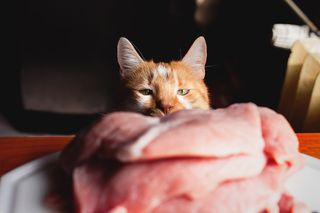'Raw' Diet for Pets Not As Healthy As You Might Think

Wild relatives of domestic dogs and cats thrive on raw flesh, but a so-called "raw" diet for pets carries risks of their exposure to parasites and bacteria, a new study finds.
What's more, a pet's raw diet may put humans at risk for these infections, too.
Pet foods and treats that include raw meat, organs or meaty bones have been found to include parasites such as Toxoplasma and tapeworms, as well as the bacteria Escherichia coli, Listeria monocytogenes, Brucella suis and Salmonella, according to a study recently conducted in the Netherlands. Introducing these pathogens into homes through contaminated pet foods presents the possibility that they could also sicken people, the study authors reported. [These 7 Foods Cause the Most Pet Deaths]
Pet owners who choose to feed their animals with a raw meat-based diet (RMDB) may think that they're offering their pooches or felines a healthier choice. But no studies show that these diets provide health benefits — if anything, prior research has documented that the opposite is true, the scientists explained in the study. RMDB feeding was linked to gastroenteritis and diarrhea in dogs, and to a deadly type ofSalmonella infection in cats, according to the study.
Previous findings also note that RMBDs can lack important nutrients, which can lead to health problems — particularly in young animals. These diets have contributed to pets developing hyperthyroidism (an overactive thyroid gland), and have even resulted in injuries such as fractured teeth and gut perforations, the scientists reported.
Since dogs diverged from their wolf ancestors more than 10,000 years ago, genetic differences have also emerged that have left dogs better equipped to handle a diet that includes starches as well as meats. Dogs have more copies of a gene that produces amylase — an enzyme that breaks down starches — than wolves do, and this gene is 28 times more active in dogs than in wolves, researchers reported in 2013.
Currently, as many as 1 million Dutch households provide their pets with a diet that includes raw meat or raw by-products, the researchers wrote in the study. To see what microorganisms might be lurking in the food, they tested 35 products containing different types of raw meat and meat by-products, including chicken, beef, lamb, duck, rabbit, horse and turkey.
Sign up for the Live Science daily newsletter now
Get the world’s most fascinating discoveries delivered straight to your inbox.
They found E. coliin 86 percent of the products, while 54 percent included L. monocytogenes and 20 percent held Salmonella. Parasite DNA was detected in 29 percent of the samples, the scientists discovered.
In general, the microbial evidence that the researchers gathered from their samples fell within acceptable limits for commercially produced pet products in the Netherlands. But the amount of E. coli in 40 percent of the RMDBs exceeded the threshold for safe human consumption, and a person could become infected with the bacteria through contact with the pet food; with contaminated surfaces; or with an infected pet, the researchers reported.
And Salmonella speciesanalyzed in the study presented another unpleasant surprise — they were resistant to antibiotics, which would make infections difficult to treat.
"It is important to encourage awareness of the possible risks associated with feeding RMBDs to companion animals, and pet owners should be educated about personal hygiene and proper handling of RMBDs," the study authors concluded.
The findings were published online yesterday (Jan. 11) in the journal Veterinary Record.
Original article on Live Science.

Mindy Weisberger is an editor at Scholastic and a former Live Science channel editor and senior writer. She has reported on general science, covering climate change, paleontology, biology, and space. Mindy studied film at Columbia University; prior to Live Science she produced, wrote and directed media for the American Museum of Natural History in New York City. Her videos about dinosaurs, astrophysics, biodiversity and evolution appear in museums and science centers worldwide, earning awards such as the CINE Golden Eagle and the Communicator Award of Excellence. Her writing has also appeared in Scientific American, The Washington Post and How It Works Magazine.

